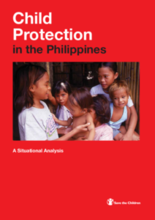This situational analysis was commissioned by the Child Protection Initiative (CPI) as a preliminary exercise to develop evidence-based recommendations to guide Save the Children in the Philippines to develop interventions under the CPI priority result areas, building on existing programmes and technical expertise. Save the Children in the Philippines seeks to prioritise across the following strategy areas: children in residential care, children in armed conflict and disasters, children in situations of migration (including for trafficking purposes), and children in exploitative and hazardous work conditions.
Specifically this study aimed to a) conduct a rapid assessment of the situation of children in the Philippines in relation to the CPI priority result areas; b) identify gaps in existing policies, programmes and services; and c) provide a set of recommendations for Save the Children child protection interventions.
This Situation Analysis covers the period 2000-2009. This decade may be considered as a very trying period for the Philippines, and continues to be so as the country faces the challenges of an ever ballooning population, massive poverty, the increasing disparity between the rich and the poor, growing lack of livelihood opportunities, continuing exodus of skilled workers, political instability, a bureaucracy riddled by corruption, and pockets of civilian strife and armed conflict. This study looks into the following elements of effective child protection systems: a) knowledge about the root causes to and the extent of violence against children in the identifi ed priority area; b) appropriate policies and regulations; c) prevention measures; d) provision of necessary treatment, rehabilitation and compensation to child victims; and e) ways to monitor and measure progress.
Informed by a Child Rights Situational Analysis framework, the following aspects were examined for each of the priority areas:
• The nature, extent, geographical distribution and prevalence
• Which children are in need of (or are at the risk of needing) care and protection
• The chief factors that put these children at risk, covering both the immediate and root causes of harm
• The views of children themselves on their situation and what should be done to improve it.
Research documents, case studies, census data and other statistical information that cover the period 2000-2009 were actively sought and collected. Meanwhile, a total of 9 key informants from selected NGOs and other organisations identified by Save the Children in the Philippines served as key resource persons for particular CPI areas.
Chapter 3 of the report looks at the situation of children in residential care. it found that out of the four priority areas included in this study, children in residential care received the least amount of attention in terms of research and documentation. In 2003, a total of 2,732 children were reported to have been deprived of a family environment and separated from parents. Of this number, about 98.31% or 2,686 children were brought to institutions. Males comprised the majority (1,655) compared to females (1,031). The data was silent as to what happened to the remaining 46 children who were not brought to institutions. No data beyond 2003 was available at the time of the study.
According to the study, in the Philippines, residential care remains to be the primary response to child abandonment, neglect and abuse. Residential care, or care provided in any nonfamily-based group setting, such as places of safety for emergency care, transit centres in emergency situations, and all other short and long-term residential care facilities including group homes, is only one of the many forms of alternative care. Other forms of alternative care include:
• Kinship care: family-based care within the child’s extended family or with
close friends of the family known to the child, whether formal or informal in nature;
• Foster care: situations where children are placed by a competent authority for the purpose of alternative care in the domestic environment of a family
other than the children’s own family, that has been selected, qualified, approved and supervised for providing such care;
• Other forms of family-based or family-like care placements;
• Supervised independent living arrangements for children.
Contrary to popular belief, most children in residential care are not orphans, but have one or both parents alive, as well as other relatives who could care for them. They are likely to be separated indefi nitely from their families and communities. Children are primarily placed in residential care by their families because they are too poor to look after them. Families often feel it is the only way to ensure that their children get an education and enough food and other essentials. For example, parents bring their children to religious convents in the hope that the institution would take them in. Some parents convince their children to consider a religious vocation so as to ensure board and lodging, and education for them in the future.
©Save the Children Child Protection Initiative in Southeast Asia and the Pacific

